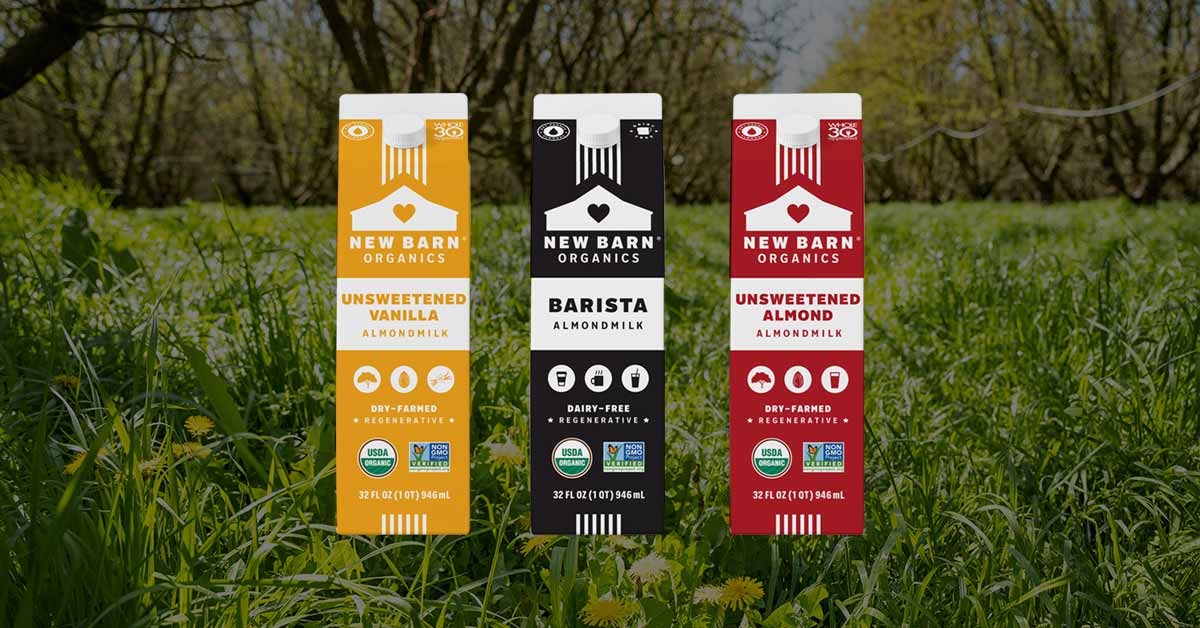
Though regenerative agriculture is one of CPG’s buzziest topics, brands and growers still face significant hurdles in establishing a viable market for these products. As it prepares to transition its complete portfolio to Regenerative Organic Certified (ROC), an effort that kicks off today with the announcement of its flagship almond milk earning the seal, longtime plant-based player New Barn Organics is set to put its business model to the test.
For New Barn co-founder Ted Robb, the challenge is aligning that progressive ambition with the company’s bottom line. Despite the investment needed to certify the full supply chain of each product – which includes farm audit fees, sourcing partner transitions, packaging refreshes and more – Robb said the brand will not increase prices with the addition of the ROC label.
“We’re actually trying to really make sure that we keep our price points accessible and then we go after reaching as broad of an audience as makes sense,” said Robb.
He noted that due to the product’s premium ingredients and positioning, it has always carried a slightly higher price tag, at $9.80 per 32 oz. carton. By embracing long term regenerative farming partnerships, Robb said suppliers and in turn, the brand, are actually able to optimize their businesses.
“One of the things we’re talking about is how do you create more stacked enterprises on the almond farm,” said Robb. “Can they [raise] chickens? Can they [cultivate] honey? What are the ways that the farm can actually produce more output in a regenerative manner? So it’s not just the soil health, it’s also the economics.”
This isn’t New Barn’s first regen ag move either – the NestFresh-owned brand rolled out the first ROC-certified chicken eggs in November 2021. According to Robb, the brand “cut its teeth” on the ROC certification with eggs as that supply chain had the most “visibility” from its parent organization. Since all ingredients and intermediaries involved in each ROC product must undergo an audit to earn certification, the single-ingredient product was an easy entry point for New Barn’s regen push.
Almondmilk is New Barn’s second-lowest ingredient product, featuring almonds sourced from California-based Burrough Family Farms, the first ROC-certified almond farm. The company had previously sourced almonds from regenerative dry almond farmers in Italy and Spain but was unable to obtain audits for those farms in a timely manner when it began the process during the height of the pandemic. At that time, Burrough was looking for a branded product to bring its ROC almonds into the market and Robb said the rest just fell into place. Since then, New Barn has spearheaded the ROC process across a range of ingredient supply chains including getting the first vanilla producer ROC certified.
“In our own little way, we’re able to create some momentum and inertia there,” said Robb. “That’s where [New Barn] really started from and hopefully will continue for as long as the brand around, we will look for ways that we can make positive improvement.”
Certifying supply chain partners and linking them with brands has been said to be the most effective way to increase the rate of farms transitioning to regenerative growing methods. New Barn’s coconutmilk is already being made from regenerative ingredients, and is labeled to reflect that; however, the supply chain for regenerative coconuts involves a network of small family farms based in the Philippines, meaning completing audits for each individual producer can slow down the process, Robb explained. New Barn’s coconutmilk will carry the ROC badge by 2024.
“Everyone has to find their own way to get their arms around [regen ag],” said Robb.
While it works to get the full line certified, Robb said retailers that align with New Barn’s mission have been eager to get the Almondmilk on shelf. He noted that in the past the company “exploded out of the gate,” but has worked to take a more thoughtful approach to growth since its acquisition. Since pulling the brand back to focus on West Coast markets as well as DTC, it has been able to better define the New Barn consumer and grow the brand accordingly.
Through its DTC platform, the brand sees an average order size of 8 cartons, totaling $70. It boasts a lifetime consumer retention rate of 55% and Robb also noted that half of the brand’s DTC consumers start their purchase via the carton’s “FlowCode,” a QR code on the carton that links to the brand’s website, signaling that New Barn consumers are actively looking to engage with brand in addition to purchasing the product.
The move also continues to build on New Barn’s own maturation. In 2018, the company rebranded New Barn Organics – signaling a future commitment to organic foods – and Robb said this push to support regenerative simply builds on the company’s original tenets.
“We exist to make food better and I think what that means to us is that everything we do with New Barn, it’s really about looking at what are the longer term decisions that go into the product that we’re making?”
As the regenerative movement has grown, many have compared it to the rise of organic, but Robb doesn’t see price premiums as a way to grow regen brands. New Barn’s supply partners already enjoy the organic price premium over conventional commodity products, he said. While he believes the two are comparable, he hopes this movement will evolve not as “an opportunity to gouge the consumer” or a mode to incremental profit, but rather as an opportunity to continue “reinvesting into the brand.”